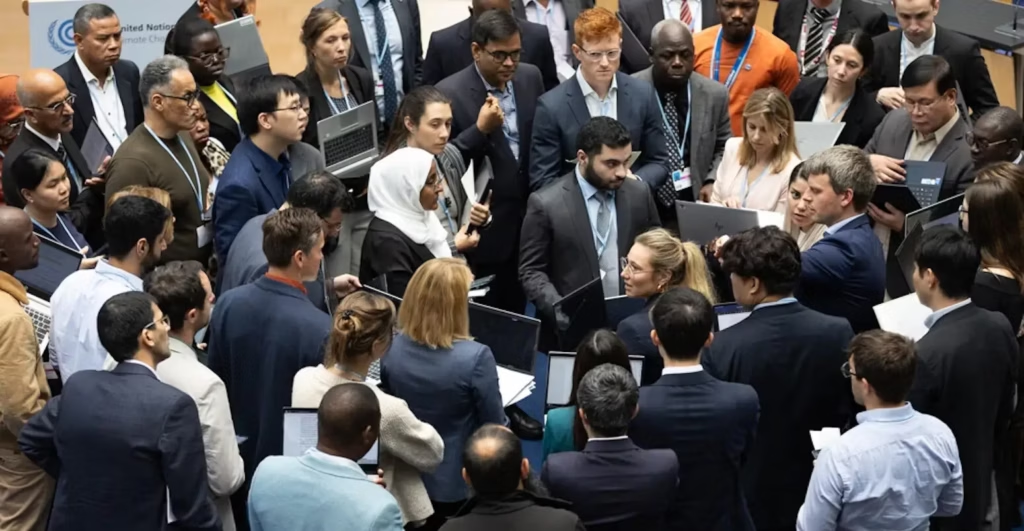
Carbon Brief has published a nice summary, reprinted below, of the key issues being discussed at COP29 (see Who wants what at the COP29 climate change summit – Carbon Brief).
Finance
The biggest issue at COP29 will be the “new collective quantified goal” (NCQG) for climate finance. Nations have been deadlocked for months in discussions over the details of this target, which must be agreed this year. This is set to replace the existing target – agreed in 2009 – for developed countries to provide $100bn annually from 2020 to developing countries, in order to help them cut emissions and prepare for climate change.
Following this initial target, when the 2015 Paris Agreement was decided, nations also committed to scaling up climate finance provisions for developing countries “from a floor of $100bn” from 2025. Multiple assessments have concluded that developing countries will need support to invest many trillions of dollars in the coming years in order to achieve their climate commitments.
Many developing countries have suggested a target in the region of $1tn a year or more, but developed countries – who have so far been responsible for providing climate finance – have been hesitant to suggest any numbers. Yet the number, or “quantum”, attached to the target is just one of the issues at stake. Negotiators at COP29 must also reach a decision on who is responsible for providing climate finance, where it should come from and how it should be defined.
Broadly speaking, developing countries would like to see the money coming largely from public funds provided by developed countries. Meanwhile, developed countries would like to see wealthy, emerging economies share some of the burden, as well as a greater emphasis on other sources, such as private investment and development bank reforms.
(For more information about the different issues at stake in the NCQG negotiations, see Carbon Brief’s in-depth Q&A on the topic.)
Article 6
Another issue that the COP29 presidency has highlighted as one of its “main priorities” is the full launch of Article 6 carbon markets. This includes the full “operationalisation” of both direct country-to-country trading under Article 6.2 and an international carbon market under Article 6.4, known as the “Paris crediting mechanism”.
This area has been unresolved for years and discussions at COP28 that sought to sort out outstanding technical issues ended with a lack of agreement. This failure means that, for example, it has been unclear what kinds of projects could generate credits to trade under the Article 6.2 and 6.4 systems. There was movement on some of the minor issues under Article 6 at the climate talks in Bonn earlier this year, but much remains to be decided at COP29.
Outstanding topics include whether or not parties can reserve the right to revoke authorisation of credits they have issued, as well as how confidential parties can be about trades they make with other countries. Ahead of COP29, the Article 6.4 supervisory body agreed on a mandatory “sustainable development tool”, as well as on two key standards for projects that want to generate carbon credits for sale under the new market.
The first standard is on methodologies for calculating how many credits each carbon-cutting project will be able generate, while the second is on what counts as “carbon removal” and how to deal with reversals – for instance, when a reforested area is lost to wildfire.
The way in which the supervisory body adopted these standards was somewhat controversial and may or may not be approved at COP29. While parties at COP29 will still be able to raise issues with the package produced, this could make the path to an outcome at the summit more streamlined.
[For an update on this issue, see this article from the Carbon Herald: COP29: UN Approves Article 6.4, Launches Global Carbon Market]
Global stocktake and mitigation
Following COP28, parties have clashed over how to carry forward the outcomes from the summit, including its headline-grabbing call for all countries to contribute to “transitioning away from fossil fuels” and reaching global net-zero by 2050. This pledge emerged from the “global stocktake”, which also included contributing to tripling renewable energy capacity and doubling the rate of energy efficiency improvements globally by 2030. Countries were asked to continue discussions under the “UAE dialogue on implementing the global stocktake outcomes”.
However, there has been disagreement over what this dialogue should cover. Developed countries and small islands are among those seeking to include a focus on efforts to cut emissions, as well as all the other stocktake outcomes. For example, the EU says the dialogue should “keep track of…implementation” across all stocktake issues, including mitigation, finance, adaptation and so on. The EU wants the global stocktake outcomes to be incorporated into “all relevant work programmes and constituted bodies”, including in particular the ongoing “mitigation ambition and implementation work programme” (MWP).
This comes as nations are expected to launch new climate plans – known as “nationally determined contributions” (NDCs) – by February next year. The stocktake “encouraged” countries to ensure that this new round of NDCs is “aligned” with the Paris Agreement’s stretch target of limiting global warming to 1.5C – although the meaning of “aligned” is unclear
Yet some developing nations, including the Like-Minded Developing Countries (LMDC) groups – which includes China, Saudi Arabia and India – argue that the UAE dialogue should be “solely focused on finance”. Moreover, they argue there is “no mandate for any activities which ‘take stock’ of progress of the implementation of the Paris Agreement” outside of the five-yearly stocktake process.
Adaptation
At COP28, countries agreed on a “framework” to guide countries’ adaptation actions under the “global goal on adaptation”. As part of this, they set up a work programme to develop a set of universal “indicators” that can be used to track countries’ progress on adaptation. Negotiators will continue this work programme at COP29, following slow progress at the earlier talks in Bonn back in June.
Climate finance has been a constant issue in adaptation negotiations. Developing countries frequently argue that any discussion of the topic must involve money, due to the shortfall in funding for adaptation projects. Negotiators have also disagreed over the adaptation indicators themselves and which organisations should be charged with “mapping” them.
Meanwhile, following guidance from the global stocktake, nations must also have national adaptation plans in place by 2025, so they are ready to implement them by 2030. Discussions will continue around this topic including, again, questions of providing the necessary finance to support these plans.
Loss and damage
The long-anticipated loss-and-damage fund was officially launched at COP28, in what was widely seen as a diplomatic triumph for the United Arab Emirates presidency. So far, the fund has depended on the generosity of donors to fill it, as nations are not obliged to do so. Many countries have pledged money for the fund, but these amounts are tiny compared to the amount of money developing countries need to respond to climate-driven disasters.
Loss and damage will not be as high profile at COP29 as it has been at recent UN climate summits. However, there will likely still be a push from developing countries to provide more funds for it, including a separate sub-goal under the NCQG.
The Carbon Brief article also includes a table that summarizes these issues. Parsing the data, these issues can be grouped into two general categories: Issues where there is broad agreement, and issues where there is disagreement.
Issues where all countries agree
- “Climate finance” needs to be defined
- Climate finance should be aligned with nationally determined contributions (NDCs) and other national plans
- At least US$1 trillion per year needs to be mobilized by developed countries
- Financing includes a mix of public finance and other sources
- Financing largely delivered as grants or concessional loans
- All developing countries will be able access financing
- Financing will be based on needs of developing countries
- Small island developing states (SIDS) and least developed countries (LDCs) have special status
- Importance of enhanced transparency framework in reporting finance
Issues where countries disagree
- Ten-year timeframe for action (too slow for African and Arab Groups)
- Expand contributor base beyond developed countries (opposed by Africa Group, Arab Group, LDCs, and G77+China)
- Discuss the need for more domestic resource mobilization (opposed by Arab Group, LDCs, and G77+China)
- Discuss implementation of global stocktake outcomes (i.e., the process of evaluating progress on current climate goals and adjusting priorities as needed; opposed by like-minded developing countries—LMDCs—and African Group)
- Discuss loss and damage finance (opposed by EU)
For additional reading on the areas of agreement and disagreement at COP20, the Third World Network published a nice summary here: Uncertainties loom at COP29 Climate Talks
Image credit: Kiara Worth | IISD/ENB (Delegates huddle during consultations on Paris Agreement Article 6.8)

 The Global CDR Action Network (CDRANet) is a global, multi-stakeholder effort to help create global policy solutions for large scale atmospheric carbon dioxide removal. CDRANet is managed by the
The Global CDR Action Network (CDRANet) is a global, multi-stakeholder effort to help create global policy solutions for large scale atmospheric carbon dioxide removal. CDRANet is managed by the 

